
In 1828, the explorer Allan Cunningham travelled south-west from Moreton Bay in an attempt to find a route through the Great Dividing Range to the Darling Downs. Today we thought we’d visit one of his campsites, at the foot of the range, where he camped the day before he passed through what we now call “Cunningham’s Gap”.
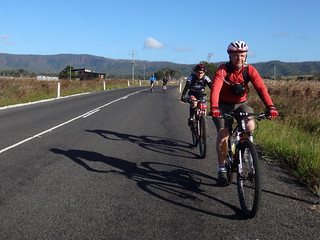
We started from the Rosevale Pub on a clear, fresh Autumn morning and headed eastwards along the paved road.

After a few minutes we left the tar in favour of the friendly crunch of gravel.
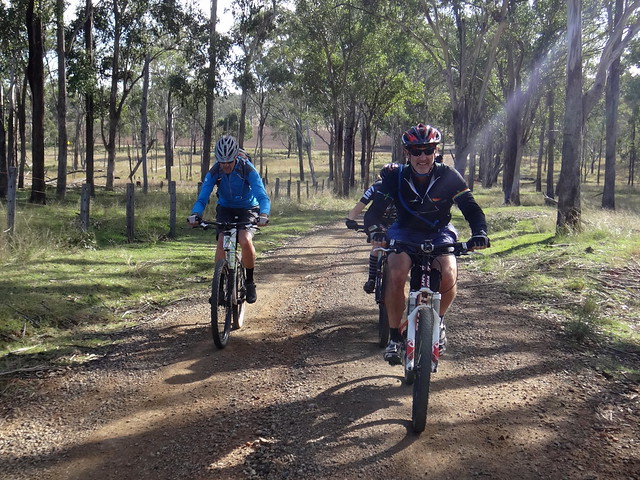
The dirt roads around Rosevale are almost maze-like in their complexity. It’s a perfect spot to explore new places on a mountain bike.

As we rolled over the hills, we could just see our destination in the distance: the rugged peaks of the Great Dividing Range.
Unfortunately, Nigel got a flat tyre after he rode over a bumpy causeway. The bump caused his wheel rim to squash his inner-tube, punching a couple of “snake bite” holes in it.

(Photo: Russel Scholl)
As with most mechanicals, there were a lot of spectators offering unsolicited advice about tubeless tyres, puncture kits and pumps. But Nigel was able to fix the puncture nevertheless.

As we continued south over rolling cattle pasture along Bald Ridged Road, the distant peaks slowly grew closer.

We then turned into Parsons Gate Road – a delightful lane which twisted through numerous farms. The roads around here have fascinating names. Who was Parsons? Where was his gate? Was he a parson? Was the Ridge always Bald?

As the Dividing Range loomed at us from behind the trees, I thought of Allan Cunningham and how he must have felt in a land thick with Eucalyptus forest, looking up at the distant rugged peaks, and wondering how he was going to get across.

And I chatted to Paul, asking how it was that we always seemed to find ourselves in beautiful locations each Saturday. Were we just lucky? Why did it always seem to work out so well? Secretly I hoped our luck wouldn’t ever run out.

As we turned into Jackson Road, the track grew bumpier. The grass grew higher. This was a perfect spot to ride a mountain bike!
Russel, our encyclopedic source of local place names, pointed out Mount Edwards and Mount French.

We arrived in Aratula in time for an early lunch. This small town sits on the Cunningham Highway, named after the man whose footsteps we were following today.

We also took some time out for more minor repairs. This time roles were reversed as Nigel gave Paul some advice about drivetrains and gears.
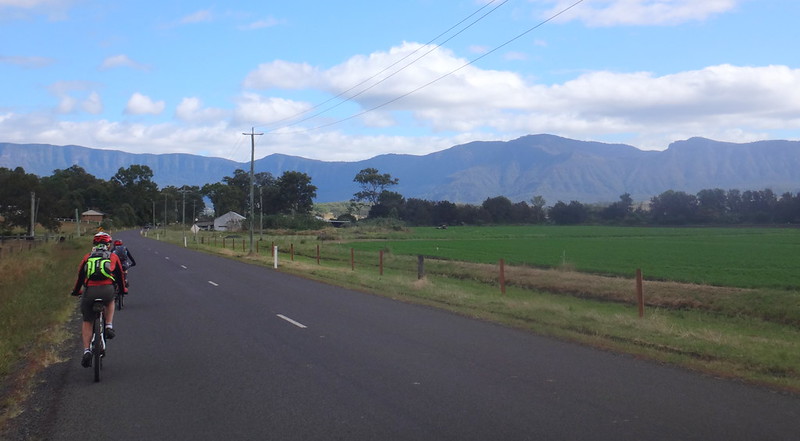
As we rode westwards on quiet back roads behind Aratula, the Range rose up ahead of us – a seemingly impenetrable wall over a kilometre high.

Cunningham’s “Gap” stood out – a chink in the armour of the range. Someone approaching from the east, and looking for a way across would obviously be drawn to such a landmark.
Unfortunately, Nigel suffered a second puncture. We suggested he inflate the tube, and submerge it in a nearby dam so he could quickly spot the leak via the air bubbles.
Sometimes the spectators give good advice 

We had left the paved road and were heading almost directly towards the Gap.
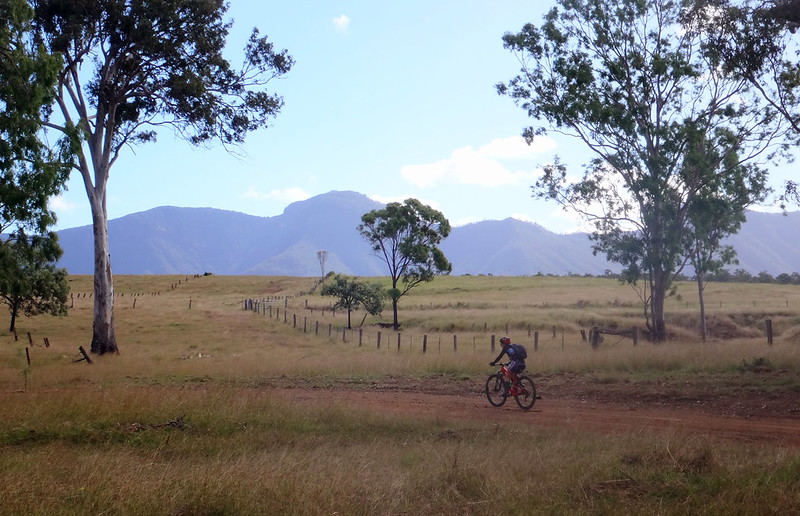
Eventually we turned into Campsite Road, named after the famous campsite. “Road” was a slight exaggeration. The fence posts leading up the hill suggested that this corridor was in fact a road reserve. We followed faint tyre tracks up the hill.

I felt like we were riding through the hills from “The Sound of Music”.

We tried our luck riding over several rocky creeks at the bottom of the hill.

Crystal clear water bubbled over rocks. This would have been a perfect area to set up a camp.
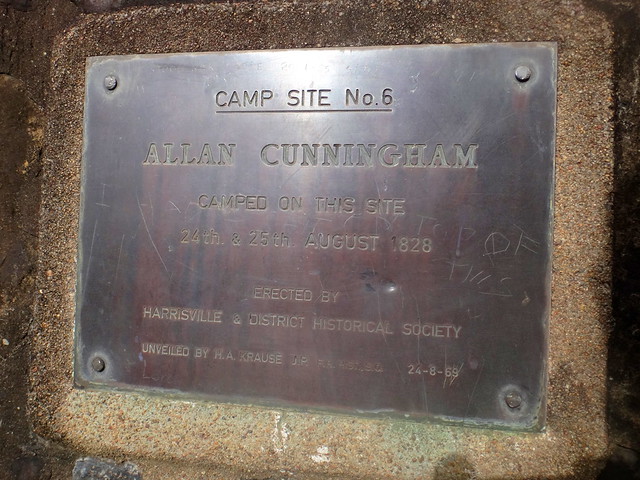
And there it was. Cunningham’s Campsite.
In his journal, Cunningham wrote:
“About one o’clock we passed a mile to the southward of our last position, and, entering a valley, we pitched the tents within three miles of the entrance of the Gap now suspected to be the pass of last year’s journey. It being early in the afternoon, I sent one of the people (who, having been of my party on that long tour, knew the features of the country lying to the westward of the Dividing Range) to trace a series of forest ridges which appeared to lead directly up to the hollow back in the range.
“To my utmost gratification he returned at dusk, having traced the ridge about 2½ miles to the foot of the Dividing Range, whence he ascended into the pass, and, from a grassy head immediately above it, beheld the extensive country lying west of the Main Range. He recognized both Darling and Canning Downs, patches of Peel’s Plains, and several remarkable points of the forest hills on that side, fully identifying this hollow back with the Pass discovered last year at the head of Millar’s Valley.


(Source: Project Gutenberg )
The year before, in 1827, Cunningham had explored the western side of the range, having travelled north from the Hunter Valley. He found what he thought would be a suitable pass through the mountains.
In 1828 he had a vague idea of the location and shape of the pass he was looking for, and returned to the area, this time travelling from Moreton Bay in the east, with Patrick Logan and Charles Fraser.
Ironically, the pass that Cunningham found the year before was Spicers Gap – about 3km to the south of Cunninghams Gap. Spicers Gap is a much easier route through the mountains, having been used by the Ugarapul aboriginal people long before European settlement. But when he returned in 1828 the lower elevation of Cunninghams Gap must have proved too alluring, and he chose that route instead. In those days it was steep and treacherous. There are stories of carts being hauled up steep tracks with ropes.
It wasn’t until 20 years later that Henry Alphen rediscovered Spicers Gap, which was then used as a stagecoach route.
If only Allan Cunningham had asked directions from the Ugarapul people 

Delighted in finding the campsite, we began the homeward leg of our journey, riding north under the shadow of the range to our left.

This part of our route followed the Bicentennial National Trail northwards towards Rosevale. Perhaps that’s why owner of the pub has placed huge “Free Camping” signs out the front of his pub.

As we climbed the hill out of the Warrill Creek valley, we had a look back at the imposing range. We could see Mount Barney and Maroon in the southeast, the Border Ranges in front of us, and the Great Divide on our left.
The slight downhill gradient and tailwind made the homeward trip much easier as we followed the Bremer River back to Rosevale.

On the drive home from Rosevale, Paul and I stopped at Cunningham’s Lookout, Warrill View. It’s from this point that Cunningham was able to see the terrain and work out the best route for his trip to the Gap.
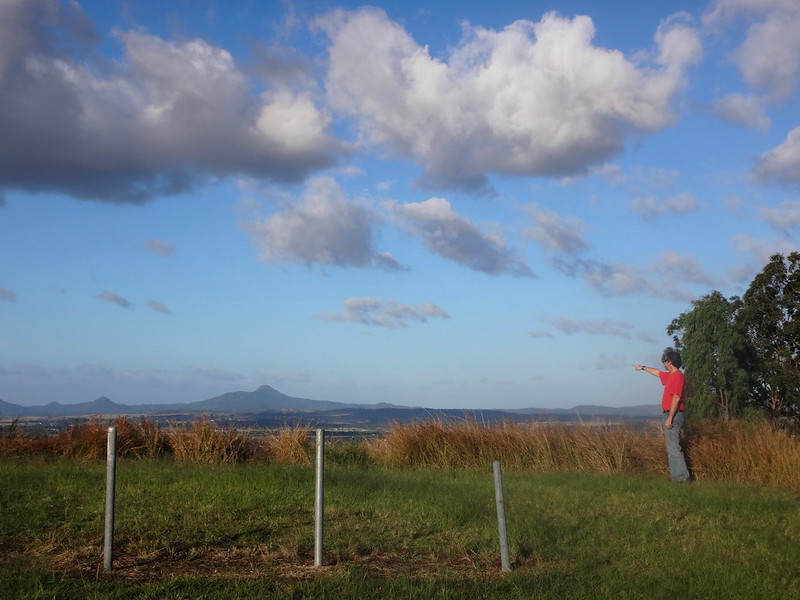
I looked north towards Laidley, and “Cunningham’s Rise” – another lookout that he had used several days earlier to plan his route.

All up we travelled 67km in about 6 hours including breaks and time stopped for repairs.
I burned about 2,900 kcal and we climbed about 950m in elevation.
This is a relatively easy ride, perfect for the cooler months with a couple of sections on paved roads.
I’ll rate it 6.5 out of 10 on the tough-o-meter.
Thanks Becca, Paul, Russel and Nigel for a great day out!




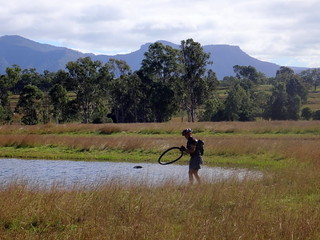










No comments:
Post a Comment